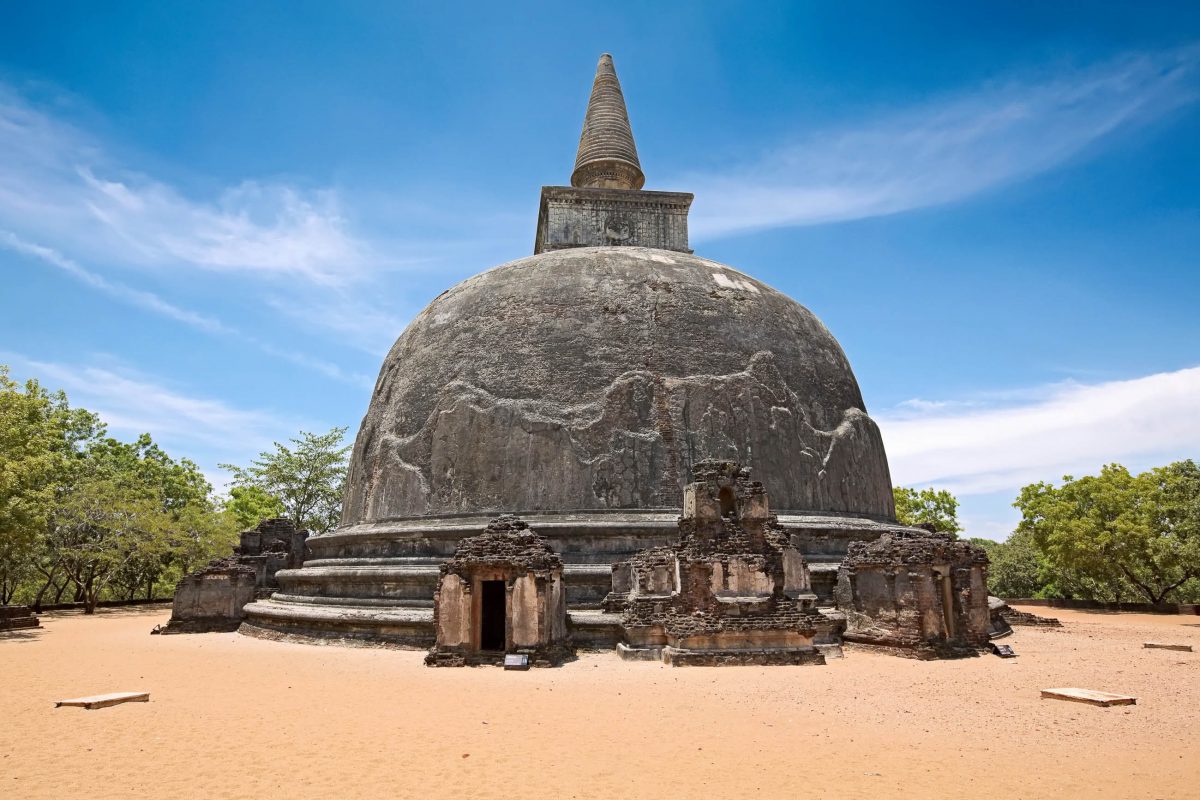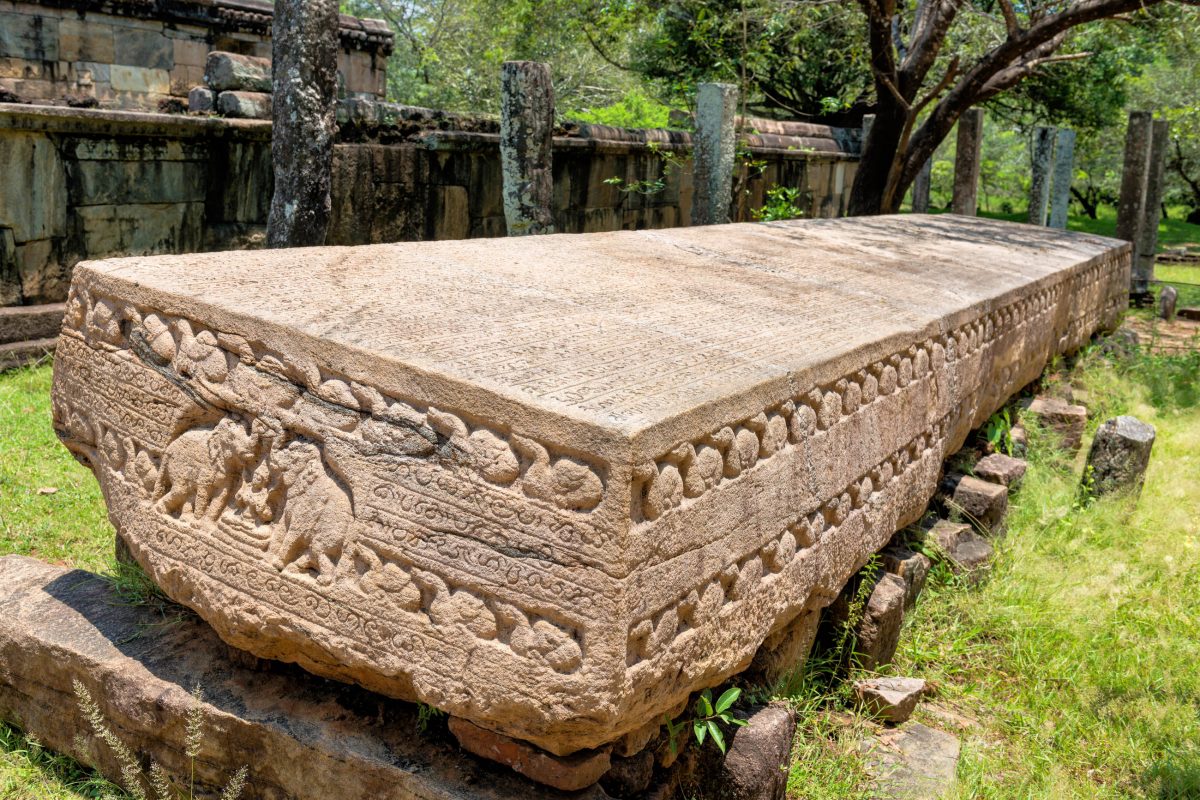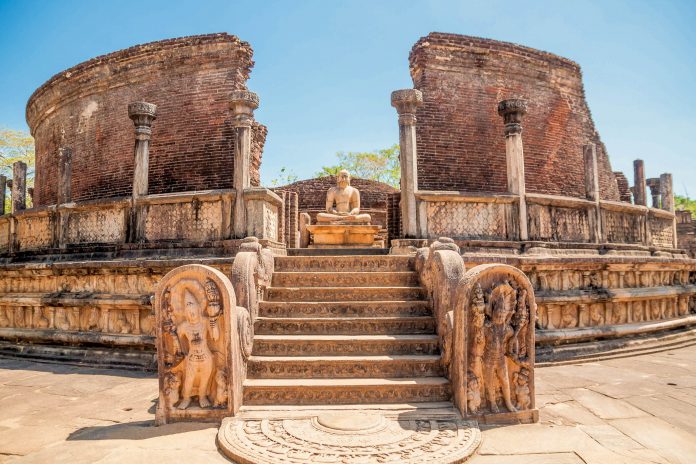Die Ruinenstadt Polonnaruwa in der Nördlichen Zentralprovinz von Sri Lanka war einst Hauptstadt des singhalesischen Königreiches. Heute zeugen beeindruckende Ruinen von ihrer prachtvollen Vergangenheit.
Die antike Ruinenstadt Polonnaruwa liegt in der Nördlichen Zentralprovinz von Sri Lanka 140 Kilometer nördlich von Kandy. Der fantastische archäologische Park gehört zu unseren Top 10 Sehenswürdigkeiten von Sri Lanka. Im Jahr 1982 wurde Polonnaruwa auf die Liste des UNESCO-Weltkulturerbes aufgenommen.
BILDER: Ruinenstadt Polonnaruwa
Fotogalerie: Ruinenstadt Polonnaruwa
Polonnaruwa wurde einst zur Hauptstadt eines mächtigen Königreiches, nachdem König Vijayabahu I. das 993 zerstörte Anuradhapura nicht mehr aufbauen wollte. Unter der Herrschaft seines Enkels, Parakrama Bahu, wuchs die Stadt zum Höhepunkte ihre Blütezeit heran. Durch die Anlagen künstlicher Seen und ein ausgeklügeltes Bewässerungssystem konnte auch während der Trockenzeit Reis angebaut werden, was ganz Sri Lanka zu großem Wohlstand verhalf.
Damals wurde hier auch die allerheiligste Zahnreliquie des Buddha aufbewahrt, die sich heute im Zahntempel in Kandy befindet. Im 13. Jahrhundert führten jedoch mehrere Invasionen dazu, dass die singhalesische Hauptstadt nach Dambadeniya verlegt wurde. 1314 wurde die Stadt aufgegeben und geriet mitten im damaligen Urwald in Vergessenheit. Im 19. Jahrhundert begannen unter den Briten die ersten Ausgrabungen.
Sehenswürdigkeiten in der Ruinenstadt Polonnaruwa

Von der einstigen Pracht Polonnaruwas zeugen heute nur noch die majestätischen Ruinen. Monumentale Stupas und eindrucksvolle Tempel und Paläste mit unzähligen Buddhastatuen ruhen inmitten von kunstvoll angelegten Garten- und Parkanlagen. Die einzelnen Ruinen befinden sich relativ dicht aneinander, sodass Polonnaruwa am besten zu Fuß oder mit dem Fahrrad erkundet werden kann. Je nach Interesse kann man einen halben bis ganzen Tag in der historischen Stadt umherstreifen.
Vatadage
Der am besten erhaltene Tempel ist der 1196 fertiggestellte Vatadage, jener Rundtempel, in der zu Hauptstadtzeiten Polonnaruwas der Zahn Buddhas aufbewahrt wurde. Die Aufgänge sind mit schimmernden Mondsteinen verziert. Zwei Wächterfiguren und vier Buddha-Statuen auf der obersten Plattform sind Zeugen der damaligen Geschehnisse.
Atadage
Im Gebäude gegenüber, in der Atadage, dem „Haus der acht Reliquien“ werden die Besucher am Ende einer Treppen von einem majestätischen Buddha begrüßt, der sitzend zwischen mehreren steinernen Säulen ruht. Auch hier wurde einst der Zahn Buddhas aufbewahrt.
Hatadage

Betritt man das dritte Gebäude, die Hatadage („Haus der 60 Reliquien“) wird man unweigerlich an die kambodschanische Tempelanlage Angkor Wat erinnert – und das mit Recht. Die singhalesischen Könige verwendeten die typisch kambodschanische Stufenbauweise zu Ehren der verbündeten Truppen aus Kambodscha.
Felsentempel Gal Vihara
Der Felsentempel Gal Vihara stammt aus dem 12. Jahrhundert und gilt als Meisterwerk der buddhistischen Kunst. Er wurde aus einem gigantischen Granitfelsen gemeißelt und ist der Höhepunkte jedes Polonnaruwa-Besuches. Die vier Buddha-Statuen gehören zu den beeindruckendsten in der ganzen Stadt, der größte von ihnen ist sieben Meter hoch und der liegende Buddha 14m lang.
Kiri Vihara
Ganz in der Nähe von Gal Vihara befindet sich eine knapp 1.000 Jahre alte Dagoba, die Kiri Vihara. Der Gründer Polonnaruwas, König Parakramabahu I. ließ sie einst für seine Königinnen errichten. Die Dagoba ist bis heute erstaunlich gut erhalten und wird auch gut gepflegt. Sehenswert ist der Feigenbaum, der die Mauer der Dagoba praktisch in sich aufgenommen hat.
Gal Pota

Ein weiteres Highlight ist das so genannte „Gal Pota“, ein Buch aus massivem Granit, welches 25 Tonnen wiegt und von der Verlegung der Hauptstadt nach Polonnaruwa berichtet.
„Neues Polonnaruwa“
Neben den historischen Stadt Polonnaruwa gibt es auch ein „neues“ Polonnaruwa mit etwa 15.000 Einwohnern, die den Polonnaruwa-Bezirk in Sri Lanka verwaltet. Sie liegt gut 5 Kilometer vom archäologischen Park entfernt und bietet auch Unterkunfts- und Einkaufsmöglichkeiten für Touristen. Dort können auch Fahrräder ausgeliehen werden, mit denen sich die spektakulären Ruinen perfekt erkunden lassen.





